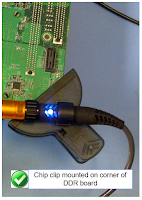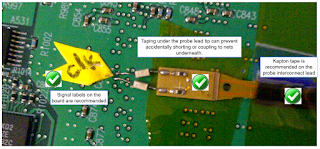 |
| Figure 1: Chip clips; they're not just for snacks anymore |
Often, the selective and judicious use of some more-or-less common household items can be of great value. One such accessory is the chip clip, which you'd ordinarily use to keep open bags of snacks from going stale. In a pinch, one of these clips can be pressed into duty, clipping it to the corner or edge of a printed-circuit board or side of a chassis as a third hand. Use these clips to hold or prop up your probe when necessary. It might be the difference between getting a good measurement or the frustration of a broken solder joint.
 |
| Figure 2: Kapton tape makes for a good insulating layer to prevent probes from shorting accidentally |
 |
| Figure 3: Avoid hot-gluing the undersides of probes |
Figure 3 shows an example of hot-gluing probe tips to a BGA ball on the back side of a single-sided DIMM. Securing the tips in this fashion facilitates inserting the DIMM into a DDR slot without imperiling the solder joints fastening the probe tips to the board.
 |
| Figure 4: Be careful about wrapping tape around the sides of DIMMs; it could interfere with proper seating of the card in a motherboard slot |
Next time, we'll begin looking at how to deal with less-than-ideal probing situations.
Previous posts in this series:
Probing Techniques and Tradeoffs (Part I)
Probing Techniques and Tradeoffs (Part II)
Probing Techniques and Tradeoffs (Part III)
Probing Techniques and Tradeoffs (Part IV)
Probing Techniques and Tradeoffs (Part V): Probe Loading
Probing Techniques and Tradeoffs (Part VI): Dynamic Range
Probing Techniques and Tradeoffs (Part VII): More on Dynamic Range
Probing Techniques and Tradeoffs (Part VIII): Gain/Attenuation vs. Noise
Probing Techniques and Tradeoffs (Part IX): Best Practices
No comments:
Post a Comment